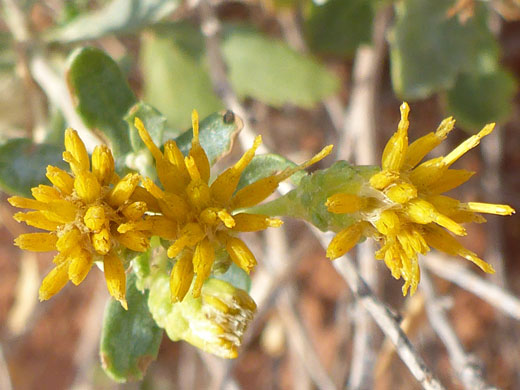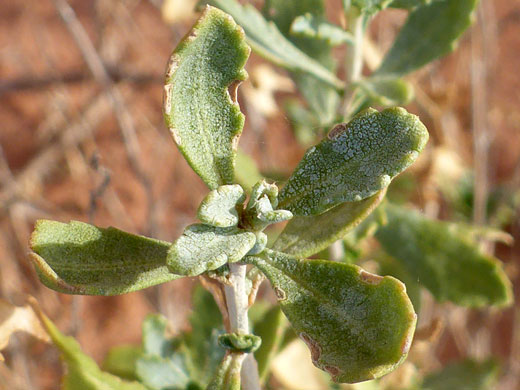Common name:
Alkali goldenbush
Family:
Scientific name:
Isocoma acradenia
Main flower color:
Range:
South/central California, south Nevada, and Arizona
Height:
Up to 4 feet
Habitat:
Dunes and other sandy places, salt flats; generally alkaline soils. Up to 3,500 feet
Leaves:
Narrowly obovate to oblanceolate, up to 3 inches long, relatively thick, often lined by rounded teeth, or lobes
Season:
August to November
Isocoma acradenia can be recognized by its pale green or whitish stems (gray when old), often shiny, and its rayless flowerheads with short, rounded, pale-colored phyllaries. Leaves are hairless, glandular and resinous, usually lined by small, irregular teeth.
Flowerheads are in small clusters (usually four or five), attached by short, bracted stalks; they contain between 12 and 27 ray florets, their corollas around a quarter of an inch long. Phyllaries have a resin pocket at the tip; they occur in three to six series.
Least common of three varieties of isocoma acradenia is var bracteosa, found in salt flats in the deserts of southern California; this has spine-tipped phyllaries. The other two have rounded phyllary tips - var acradenia with entire leaves and var eremophila with toothed or pinnately lobed leaves.
Flowerheads are in small clusters (usually four or five), attached by short, bracted stalks; they contain between 12 and 27 ray florets, their corollas around a quarter of an inch long. Phyllaries have a resin pocket at the tip; they occur in three to six series.
Least common of three varieties of isocoma acradenia is var bracteosa, found in salt flats in the deserts of southern California; this has spine-tipped phyllaries. The other two have rounded phyllary tips - var acradenia with entire leaves and var eremophila with toothed or pinnately lobed leaves.
All Contents © Copyright The American Southwest | Comments and Questions | Contribute | Site Map




